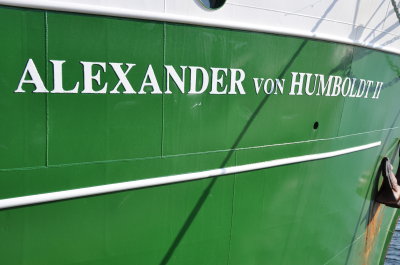Geesthacht Coastal and Material Researchers welcomed the “Alex II” to the “City of Science”
Last weekend approximately 2,500 guests visited the science exhibition of the Helmholtz-Zentrum Geesthacht at the cruise ship terminal in Travemünde where Geesthacht scientists presented their research activities and innovations. The reason for this event was the visit of the sail training vessel “Alexander von Humboldt II”. This was a great occasion for Lübeck, as this year’s City of Science, and was accompanied by a supporting programme of scientific events.

The "Alexander von Humboldt II", the partner ship of this year’s “City of Science”, Lübeck, docked in Travemünde last week. Photo: HZG/ Patrick Kalb-Rottmann
From Friday to Saturday, three islands of knowledge, set up by the Helmholtz-Zentrum Geesthacht, provided visitors to the events at the cruise ship terminal with information regarding ships’ emissions, climate change and hydrogen powered vehicles.
Dr. Torsten Fischer, head of the public relations department at the Helmholtz-Zentrum Geesthacht, stated: “As an official cooperation partner of the ‘City of Science 2012’, we were delighted to be able to converse with so many interested visitors. It was an extremely successful event and a great achievement for us.”
Geesthacht scientists from the fields of coastal, material and climate research demonstrated, by means of the FerryBox model, how the freighter Lysbris travels over the North Sea to measure the salt content, temperature and algae concentration in the water, how our climate could change in the future, and how emissions from ships spread out across the coastal environment.
Three apprentices from the Helmholtz-Zentrum Geesthacht, working together with students from the Chemnitz University of Technology, demonstrated how a hydrogen-powered car functions. The tall sailing ship “Alexander von Humboldt II“, the Russian “Mir” and numerous smaller sailing ships were docked at the Ostpreußenkai (East Prussia Quay) and opened their gangways for an “Open Ship” event.
Further information
Helmholtz-Zentrum Geesthacht
Phone: +49 (0)4152 871784
E-mail contactMax-Planck-Straße 1
21502 Geesthacht
